
Feel free to add tags, names, dates or anything you are looking for
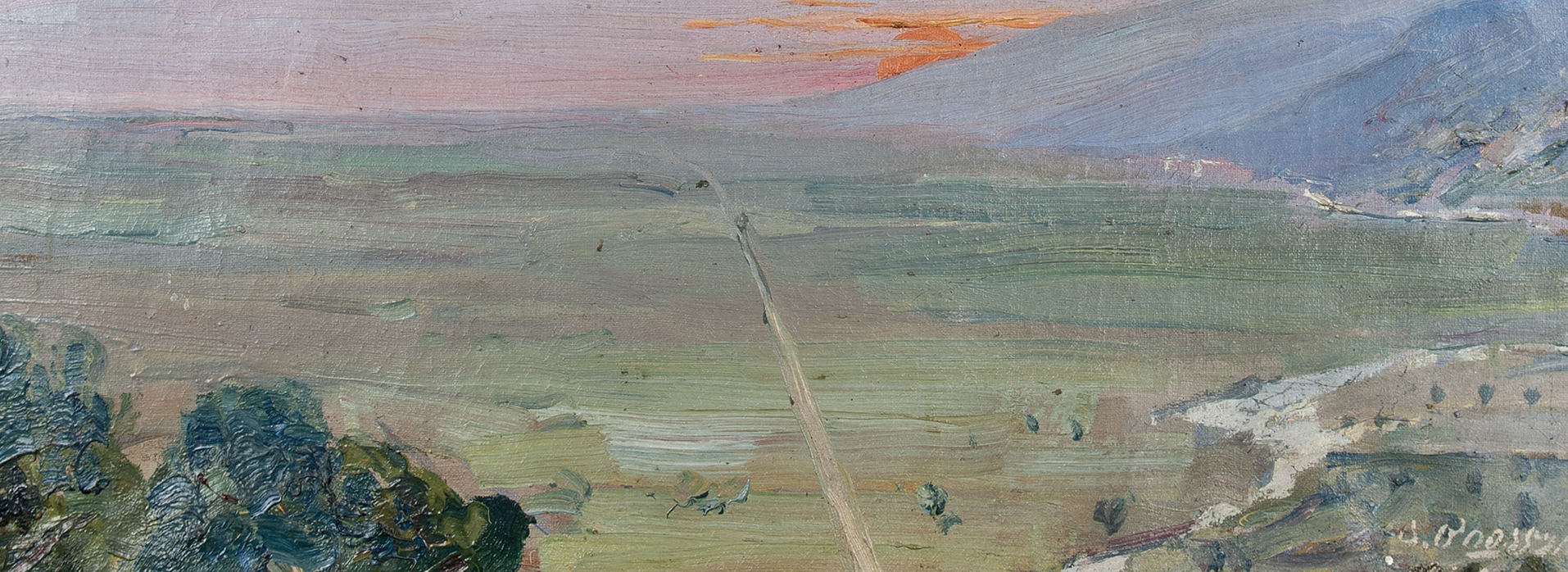
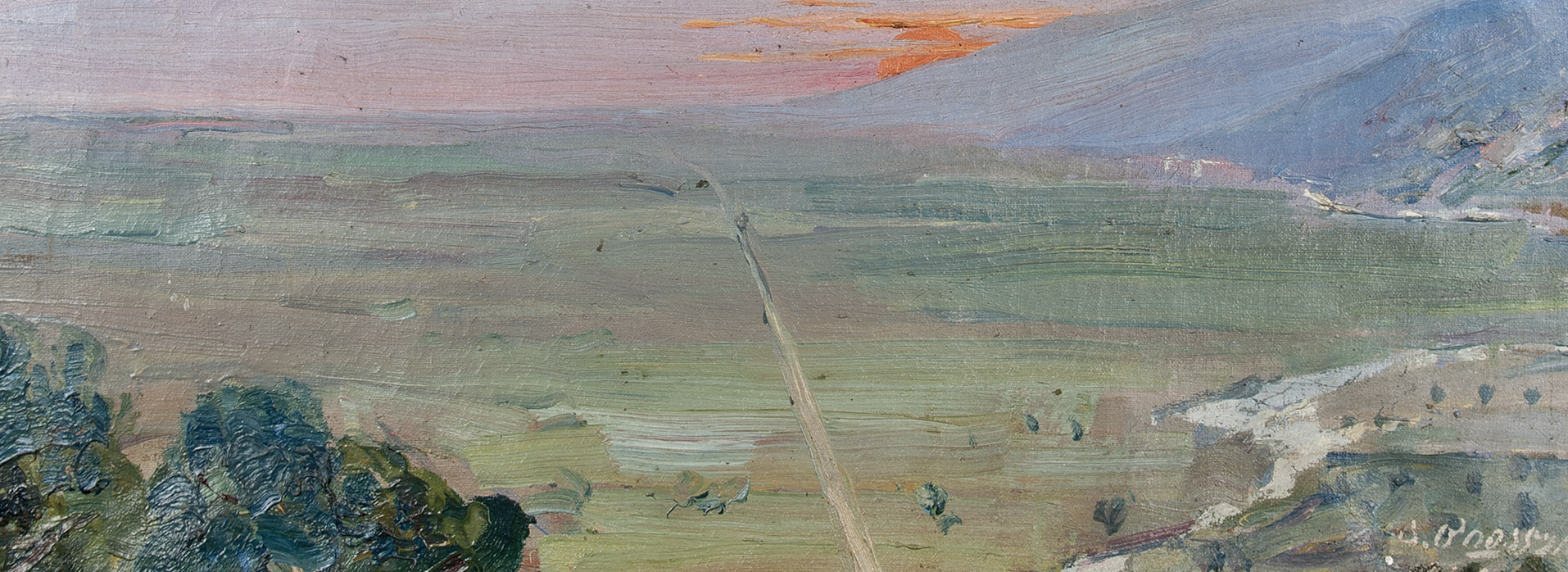
Aleksandre Tsimakuridze is recognized as one of the chief supporters of the landscape genre in 20th century Georgian realistic easel painting. Notwithstanding the significant contributions of figures such as David Kakabadze and Elene Akhvlediani, who established landscape painting both as a genre and as a thematic focus in Georgian art, it can be asserted that Aleksandre Tsimakuridze stands out as the first Georgian artist to devote himself entirely to the craft of landscape painting. Apart from a handful of portraits, Aleksandre Tsimakuridze’s artistic oeuvre is predominantly centered on landscape painting. As a result of his efforts, the genre of realistic landscape painting was firmly established in Georgian easel painting. Furthermore, the extensive years he spent teaching were equally significant, since he played a crucial role in nurturing and shaping the professional development of numerous Georgian landscape artists.
Apart from his urban views of Tbilisi (1927-1930) – a painting series which was commissioned by the Tbilisi Historical-Ethnographic Museum – the greater part of our acquaintance with Aleksandre Tsimakuridze's artistic legacy derives from his landscapes painted between the 1930s and 1950s. It seems that at that time an environment emerged in Moscow that was conducive to the talents of an artist who had a classical education in art. The impetus was to bolster and enact the trend of realistic painting, which provided an opportune moment for Aleksandre Tsimakuridze, who had returned to Tbilisi from his hometown of Kvishkheti in 1921, to carve out his own niche within Georgian art. The painter, who had been brought up in the artistic traditions of the Russian "Peredvizhniki"and the Union of Russian Artists (for whom everything modernist was both alien and unacceptable) created a "classical version" of the landscape, so to speak – thus laying the foundation for realistic landscape painting in Georgian fine art. His calm and balanced landscapes, composed in accordance with the principles of spatial perspective, bear distinct traces of his Russian academic art education. Whether depicting epic or intimate scenes, his compositions are distinctly structured. The sun-drenched landscapes of his native region are meticulously composed, using a harmonized color palette, and are emotionally evocative yet devoid of any external dynamism or dramatic flair. Aleksandre Tsimakuridze's landscapes evoke a sense of expansive openness infused with the air, even when their visual scope is limited, presenting us with a fragmented composition through close-up shots. The interplay between foreground elements that are seemingly rendered in spatial perspective and the sun-lit yet softly blurred background imbues these compositions with a sense of depth and atmosphere. Additionally, the inclusion of roads stretching into the distance, well-trodden paths, or rolling slopes, which are prevalent in most of his landscapes, gradually unfolds within the scene, further enhancing its spatial dimensions. In all other aspects – such as his fidelity to faithfully capturing the landscape as it is revealed before one’s eyes, adopting a realistic approach and perspective towards the visible elements of nature, and adhering to classical artistic principles – Aleksandre Tsimakuridze remains steadfast in upholding the fundamentals of realistic painting. The artist's sincere admiration for and emotional receptivity to the landscape revealed before him are neither fabricated by the author nor born out of fleeting euphoria during the act of painting. Before embarking on the creative process, each aspect appears predetermined – from the motif of a sun-kissed environment to an exploration of light and shadow among tree leaves, and even the selection of viewpoint or perspective – everything has been guided by the artist's inner impulse. Subsequently, his painting process strictly adheres to the timeless principle inherent in art of mimicking reality.
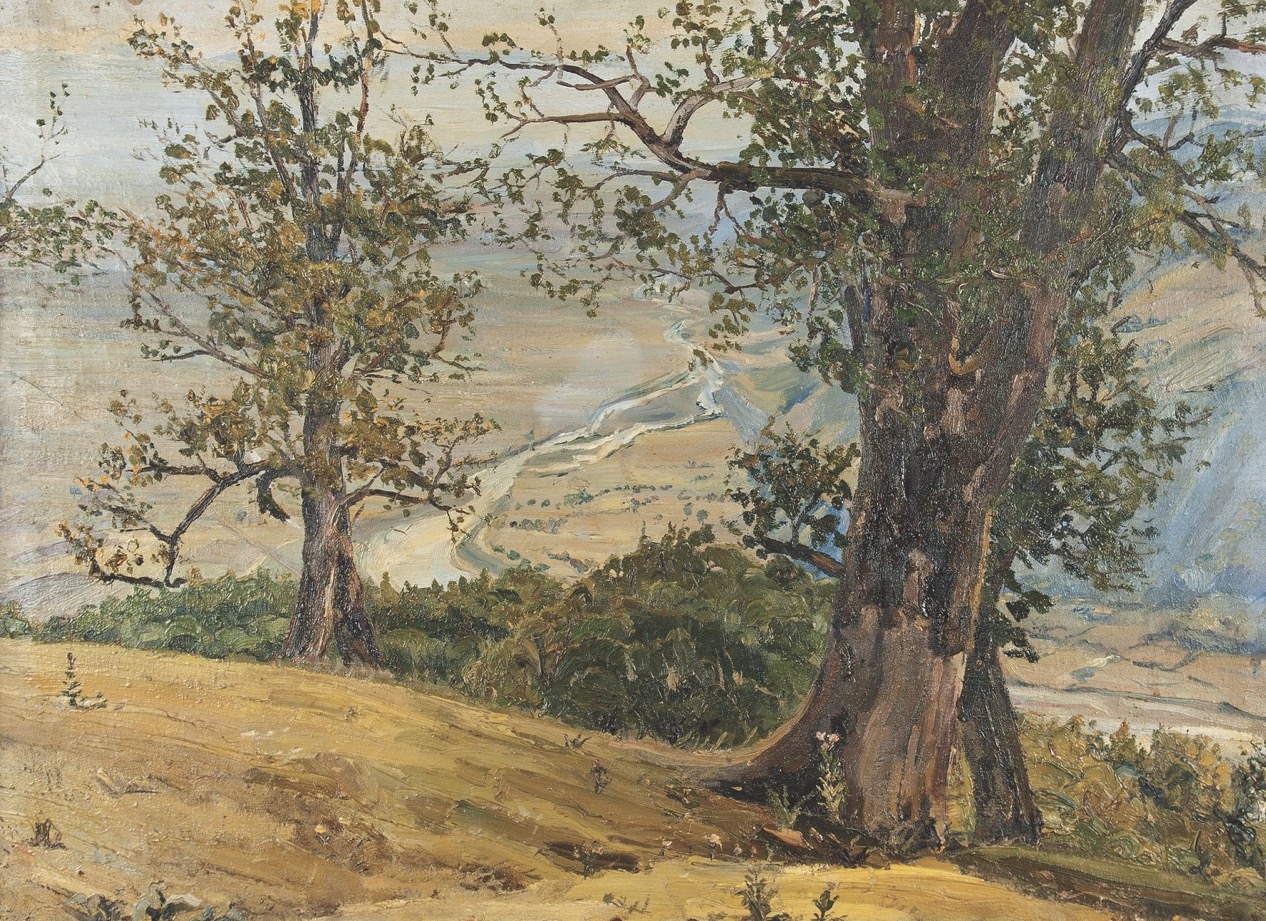
Aleksandre Tsimakuridze. Landscape. Oil on canvas. 61x83.5. 1930 © Georgian National Museum
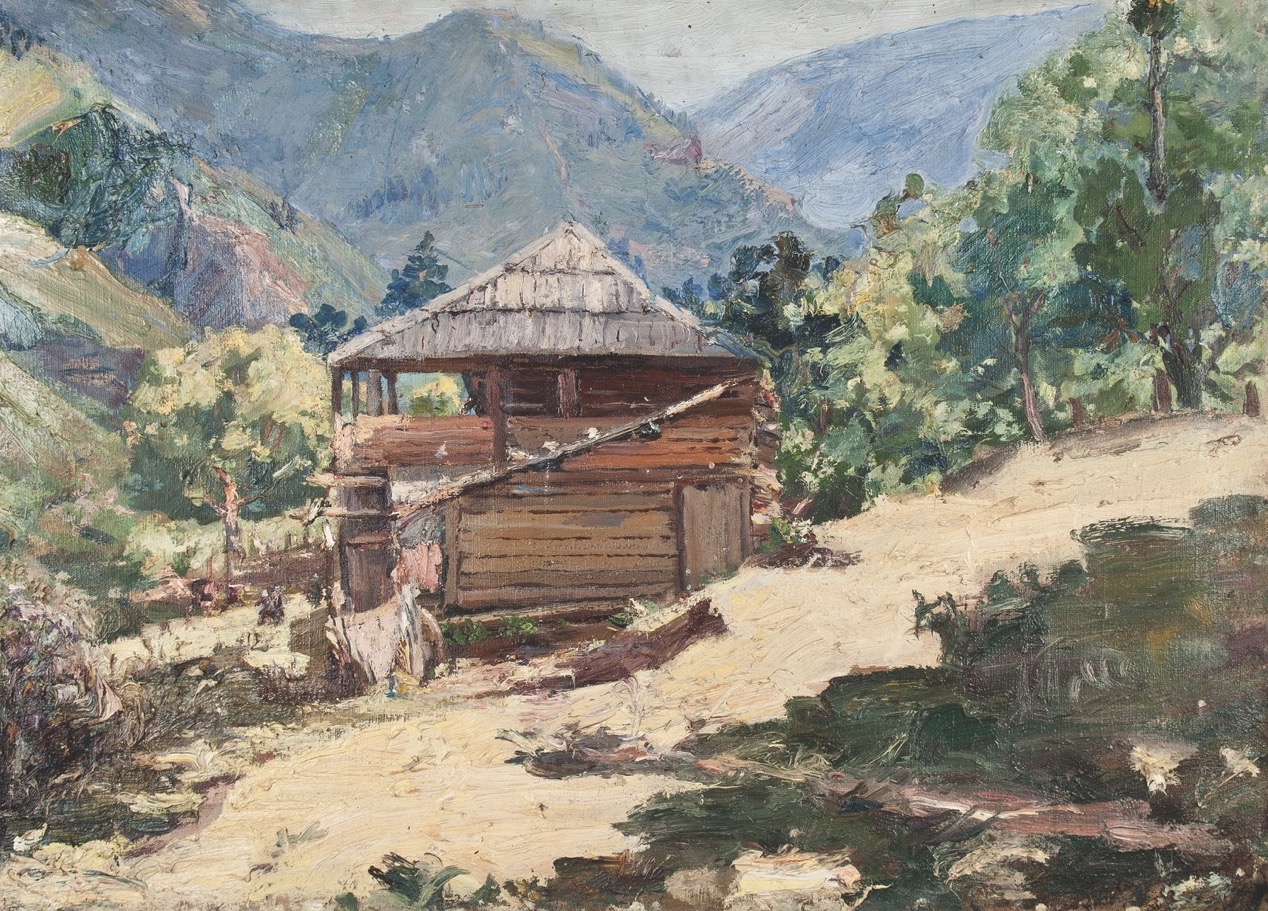
Aleksandre Tsimakuridze. Painter’s house, Kvishkheti. Oil on canvas. 72x98. 1938 © Georgian National Museum
Despite the centuries-old tradition of "realistic pictorial prose" or "prose realism," something distinctive exists in Aleksandre Tsimakuridze's landscapes, which, upon initial observation, is perceived as an invisible iconographic message and experienced by the viewer as "special." The key to this lies primarily in the compositional arrangement of the landscape. In Aleksandre Tsimakuridze's works, the landscapes are typically constructed in planes, emphasizing the arrangement of the foreground, middleground, and background planes. Notably, these planes are often aligned in the composition as diagonals converging towards the center, sometimes intersecting or diverging from one another. As a result, the scenery depicted on the canvas doesn't draw us into the depths of the artwork through the linear perspective typically associated with classical realistic painting. Instead, it "unfolds" itself before the viewer from within the depths of the painting, evincing a heightened reality that transcends mortal existence, immortalized by the power of art. Such a compositional concept is "translated" by the observer into a subliminal impulse to worship, since it is viewed as a retrospective which, no matter how odd, adds a medieval, timeless dimension to the "godless" 20th century landscapes common to realism. As a result, the foreground elements in Tsimakuridze's landscapes (whether tall firs, large trees, a wooden house, or simply a mound of earth) possess an upbeat and representational quality. Even in his unostentatious smaller-scale works, these elements are imbued with significance although they possess an unassuming existential motif. In Aleksandre Tsimakuridze's creative work, seemingly mundane and commonplace views are not only seamlessly integrated into nature and harmonious with their surroundings, they also exude a heightened sense of reality. This is where the sense of epic grandeur and sublime beauty inherent in Aleksandre Tsimakuridze's ostensibly unassuming "prose" landscapes originates, which challenges any simple explanation.

Aleksandre Tsimakuridze. Borjomi Gorge. Oil on canvas. 84x104. © Georgian National Museum

Aleksandre Tsimakuridze. Morning in Kvishkheti. Oil on canvas. 61x78. 1953 © Georgian National Museum
A further aspect of Alexander Tsimakuridze's landscapes adds to the creation of an elevated mood: a picture plane loaded with elements and a high perspective, which is a well-known facet of Georgian landscape painting. In Aleksandre Tsimakuridze's works, the scene is always viewed from above – even in the case of socialist realist themes. The viewer gazes down upon the surroundings from a lofty vantage point nestled within the mountains. The sky is scarcely visible, since the horizon is largely obscured by mountains or dense foliage, leaving only a small portion visible. What may appear as the sky is often a distant mountain, faintly blurred with a bluish hue. It can thus be argued that in the works of Aleksandre Tsimakuridze, the language and form of realistic painting not only mirror the compositional structure of David Kakabadze's Imereti landscapes, but also convey an idealistic narrative content. Nevertheless, in Tsimakuridze's creative work, the sense of eternity is less pronounced. The latter artist, rooted in the traditions of realistic painting, eschews the generalization of forms and the flat-decorative arrangement of subject matter; instead remaining faithful to visible nature, emphasizing empirical reality. By translating Kakabadze's techniques into the language of realism, Tsimakuridze instills his landscape compositions with a subtle dynamism and inner vitality. Despite its modernity, this approach ultimately enhances the realism and artistic authenticity of the completed landscapes. Aleksandre Tsimakuridze employs his own approach to capturing the impermanence of nature through the language of painting, "secretly" or perhaps unconsciously echoing the modernist tradition of Georgian painting. This constitutes a continuous artistic tradition, perhaps not fully grasped by Aleksandre Tsimakuridze, yet undoubtedly absorbed in its entirety. It represents a sort of "trans-tradition" spanning from the Middle Ages through modernism, shaping a new artistic paradigm along the way. This paradigm is both flexible and in line with the contemporary demands and standards required of painting. Simultaneously, it retains an organic, albeit discreet, connection with the fundamental essence of Georgian fine art.

Aleksandre Tsimakuridze. Painter’s house. Oil on canvas, 72.5x83.5, 1937 © Khashuri Local Museum.
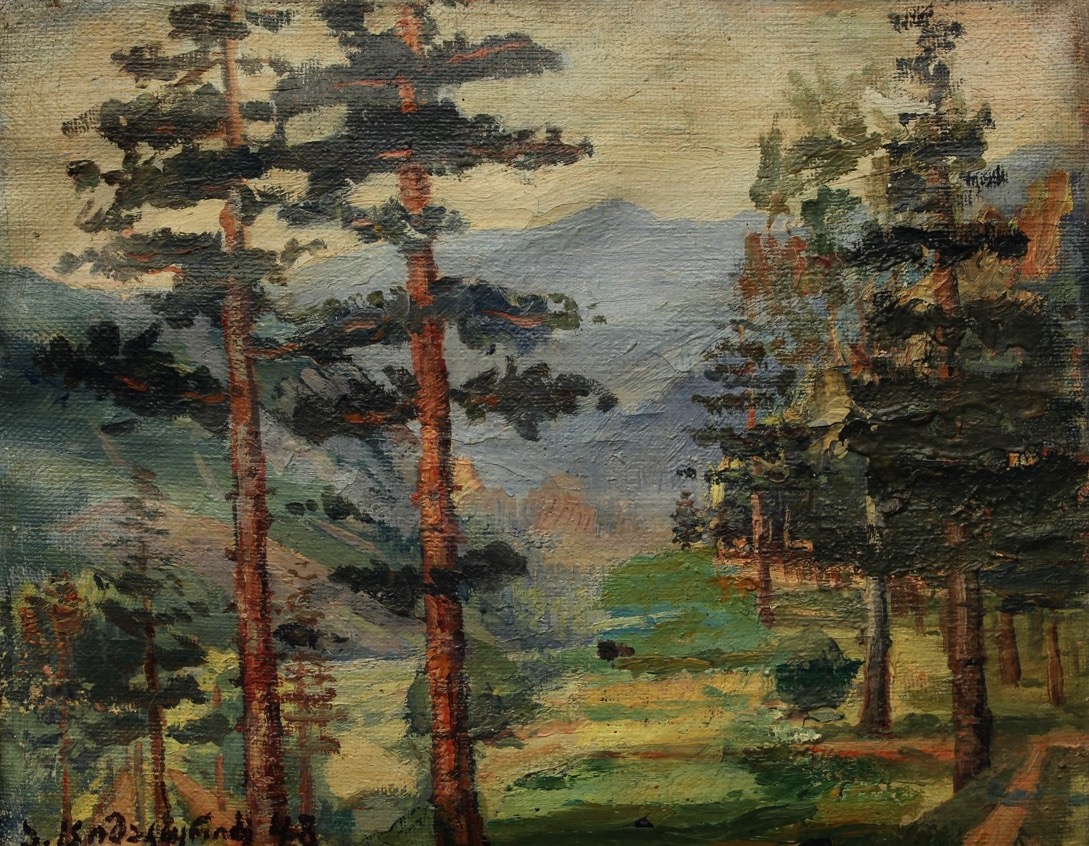
Aleksandre Tsimakuridze. Landscape. Oil on canvas, 46x55. 1948. Private collection

Aleksandre Tsimakuridze. Landscape. Oil on cardboard, 21x30. 1947. Private collection
Accordingly, for Aleksandre Tsimakuridze the landscape represents the "painting" of nature, as well as an individual reflection of a particular landscape. The artist draws endless inspiration from views of his beloved homeland, to which he often returns since they serve as both a "window to eternity" (divine aspect) and the motif for an entire spectrum of subjective emotions (earthly, individual aspects) to him. Because of this, his landscape compositions that are devoid of a storyline – where the painter is left in solitude with nature – are more authentic and highly creative, while the works created as a tribute to social realism are more violent and artificial, with the compositional techniques "scattered in an applicative way" across the landscape to conform to Soviet criteria. The peasant women or soldiers look unnatural and cause dissonance in the composition, which is perceived as a kind of imperfection in the sincere painting style that is the landscape of Tsimakuridze.
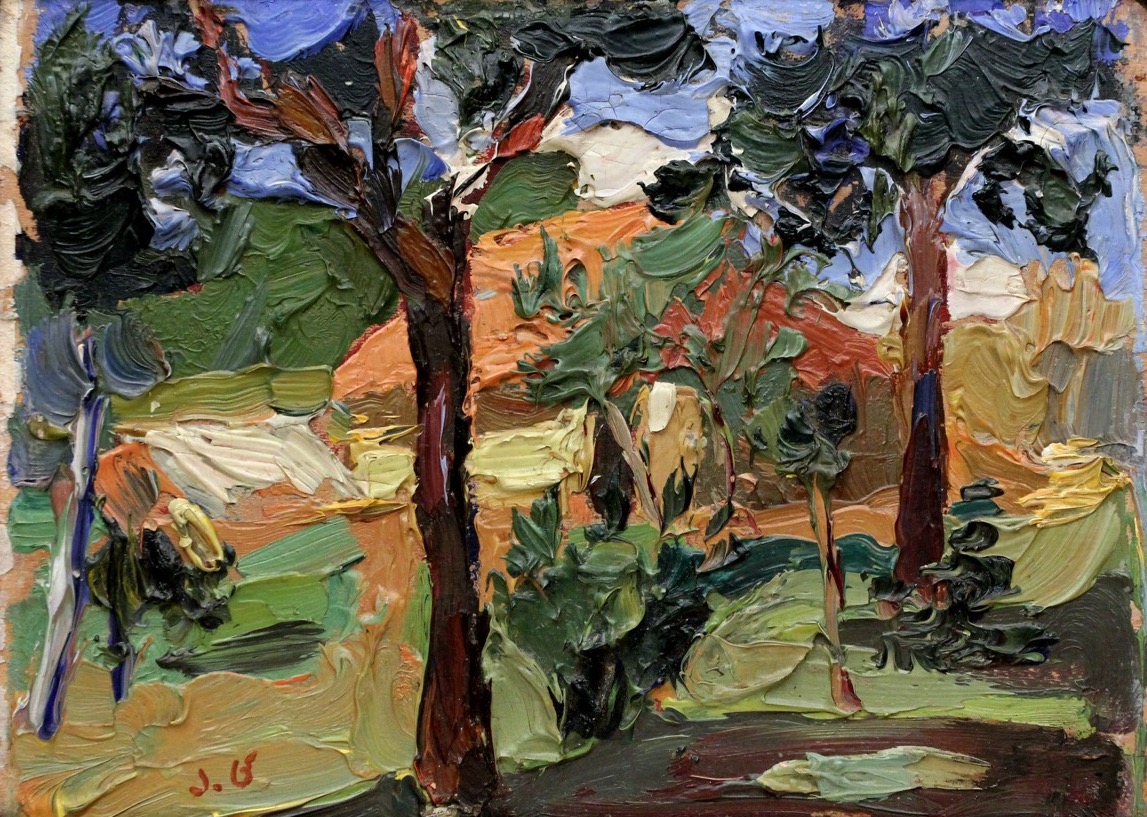
Aleksandre Tsimakuridze. Etude. Oil on cardboard, 14x19. Private collection
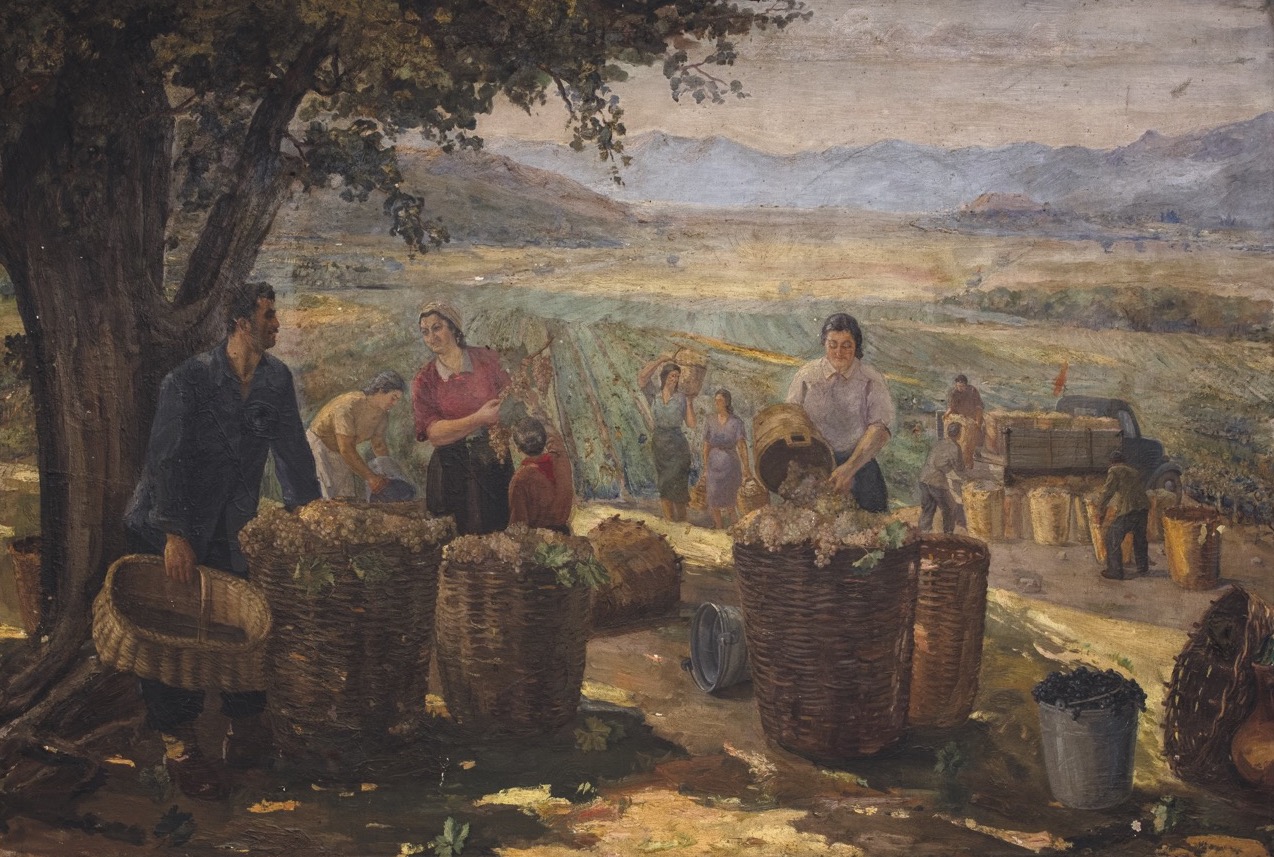
Aleksandre Tsimakuridze. On the threshing floor. Oil on canvas, 133x105. © Khashuri Local Museum
The Tbilisi views series (1927–1930), which consists of eleven paintings, holds a unique position in Aleksandre Tsimakuridze’s early period of work. One only needs to glance at the artworks to see that, for the artist the city is primarily characterized by the fantastical tales that Tbilisi’s balconied houses have provided us with, rather than representing an urban structure with a complicated landscape or maze of narrow lanes harking back to the Middle Ages. The dispersed figures are barely noticeable; they are more a part of the general entourage of Tiflis existence than real people. As a result, the urban architectural setting exudes the feeling of being abandoned. On the other hand, in spite of how peculiar it may seem, there is a wonderful festive atmosphere and a sense of celebration in this city that has been deserted by its citizens. The architectural motif is the basic and most prominent aspect of the works: it shapes and controls the composition, as well as the overall structure or spatial elements in the picture.
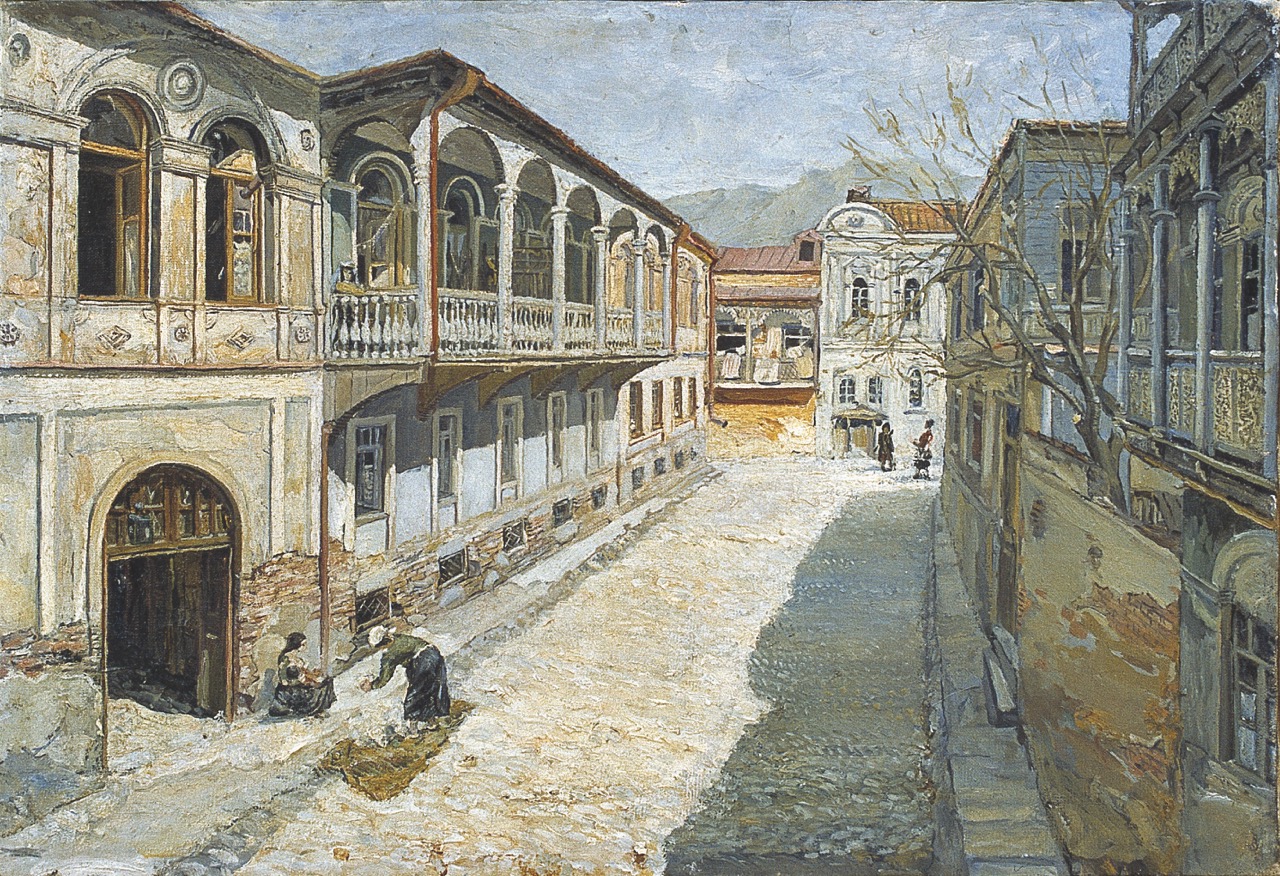
Aleksandre Tsimakuridze. Houses with Balconies in Sourb-Nishani District. Oil on canvas, 58x82. 1927 © Georgian National Museum

Aleksandre Tsimakuridze. Blue House N2 at the Abbas-Abad Square. Oil on canvas, 64x89. 1927 © Georgian National Museum
This time, through the employment of classical principles of perspective, the enormous buildings in the picture tend to be carried from left to right into the depth of the work, into a kind of “action region,” where the buildings are eventually reduced in perspective. In this way, viewers find themselves in the "captivity" of the buildings; that is, in a realistically rendered, flawlessly sculpted, self-enclosed world, which, notwithstanding the ethnographic accuracy, acquire a slightly fantastic (but not exotic) look. One has the impression that Aleksandre Tsimakuridze requires the volumetric density of buildings not so much to invoke the quality of realism and artistic persuasiveness of the views of Tbilisi, but rather on the contrary - to create a fabulous look; it is as if the artist wishes to convince us of the magic of this city, not its reality. Such a creative approach taken by Aleksandre Tsimakuridze does not completely impede the documentary nature of the mentioned series; to the contrary, it is thereby enlivened and emotionally enriched.
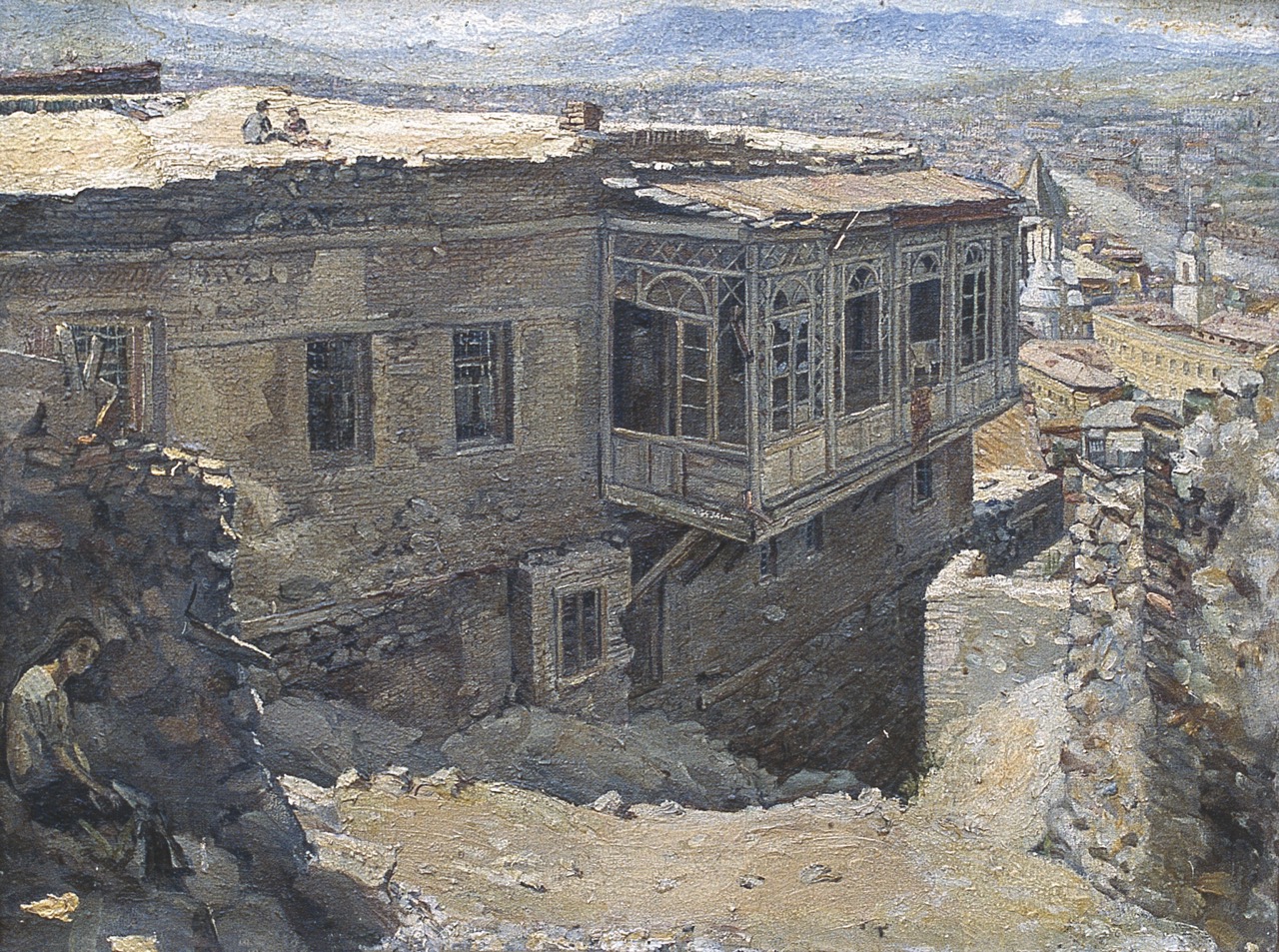
Aleksandre Tsimakuridze. Old Tbilisi, Banyan house on Fetkhaini street. Oil on canvas, 56x74 © Georgian National Museum.
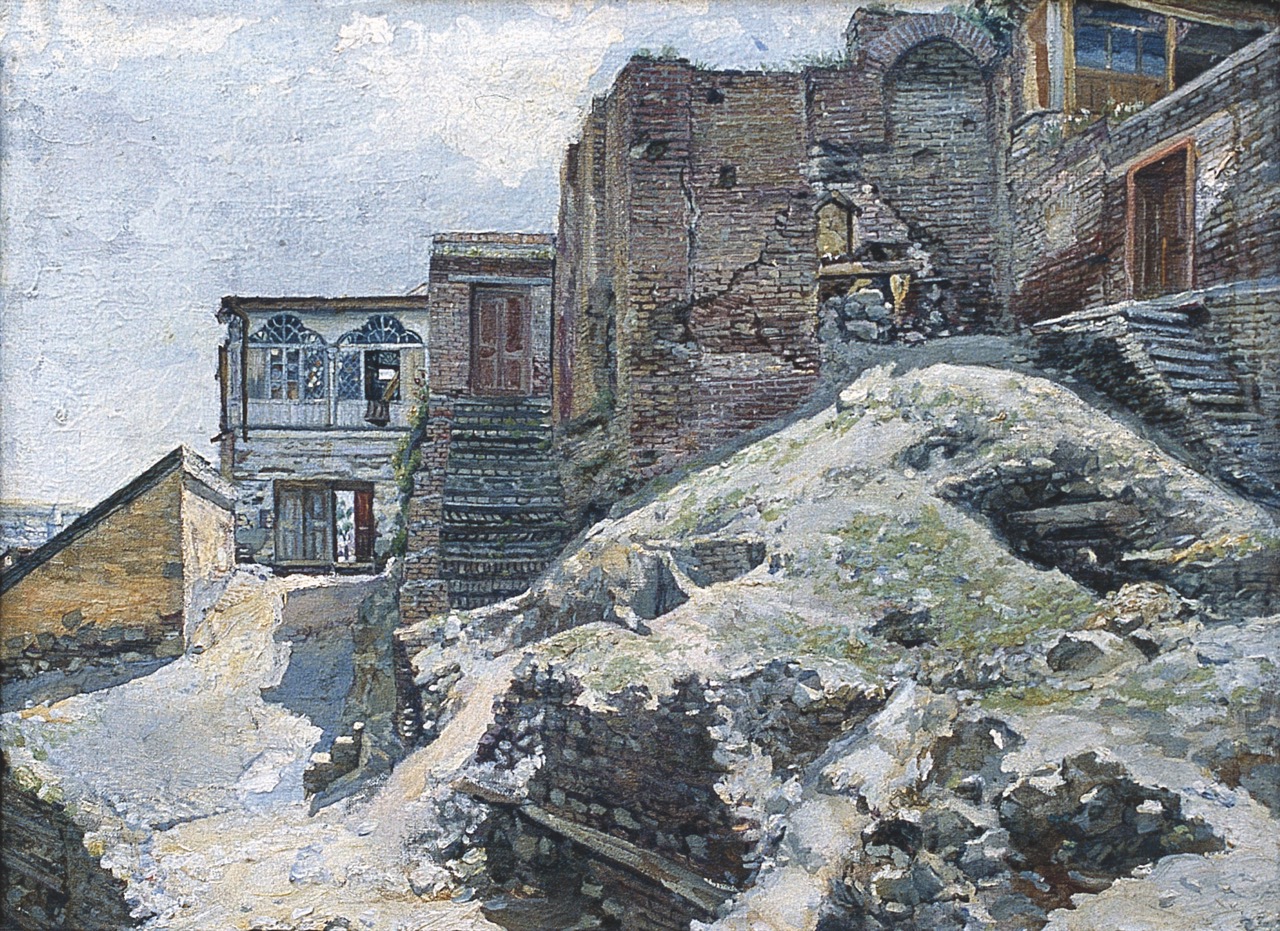
Aleksandre Tsimakuridze. Old Tbilisi, Ateshga. Oil on canvas, 61x80. 1927 © Georgian National Museum
In this way, Aleksandre Tsimakuridze imparted a "slow action mechanism" of emotion into his works, thus making future generations the true addressees of the images presented. When enough time has passed between us and the city of that period, many things (including the Tiflis lifestyle) are already destroyed, lost, or changed, while the feeling of Tbilisi speaking to the world from its balconies has faded. Aleksandre Tsimakuridze's series restores this lost sensation. The further the observer is chronologically removed from the old city, the more vital and valuable the feeling of "magical Tiflis" is brought to life for the viewer. Aleksandre Tsimakuridze's views of Tbilisi serve as "portals" through which we may travel back in time to visit Tbilisi in the early twentieth century. For this reason, we rarely see people in his urban landscapes. The artist doesn't want to use fictional characters from the past because the real characters in the pictures are us, the modern viewers. The street views presented from Aleksandre Tsimakuridze's perspective require sharp and somewhat unexpected angles in order to effectuate our interaction with and integration into the works.
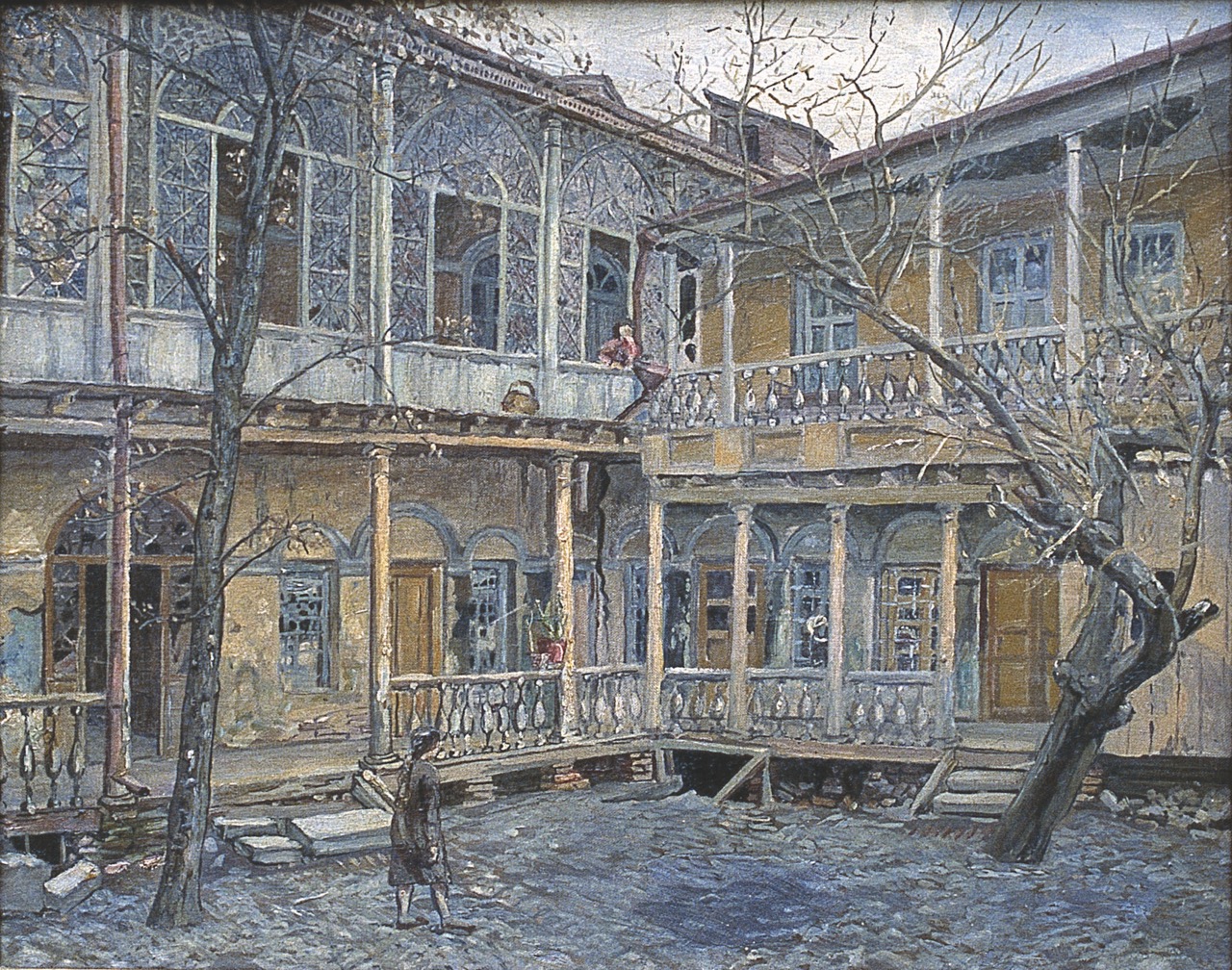
Aleksandre Tsimakuridze. The two-story house from the yard. Oil on canvas, 42x51. © Georgian National Museum.
Aleksandre Tsimakuridze creates all of this "visual magic" not merely with the language of realistic painting, but also with incredible pictorial sophistication. Strangely, in spite of the compositional constraints, a scene warmed and lighted by the southern sun is full of space and a pleasant atmosphere. The brilliant light and distinct shadow that best depict the blazing sun - brightly lit areas and hard shadows falling on the ground or the buildings opposite them - combined with the plasticity and evident materiality of the images convey an impression of space and air. This is also precipitated by the colorfulness of the paintings, which emphasizes the decorative discourse of city views. Compositions with silver-blue tones ("Ateshga," "Blue House #2 on Abbas-Abad Square," and “Balconied Houses in Sourfnishani District") are counterbalanced with warm golden tones, lending the images in this series the appearance of being invested with a light, shimmering surface that captures the warmth and heat of the sun. It splashes and looks absolutely amazing. In such a way, monumentality and decorativeness — two artistic phenomena that are typically mutually exclusive for realistic painting, but which are completely compatible for medieval monumental painting — coexist in the works that portray Tbilisi views. This further demonstrates Alexander Tsimakuridze's genetic ties to Georgian fine art, even in spite of his apparent fidelity to the Russian artistic tradition.

Aleksandre Tsimakuridze. Khalatov’s Karavansarai. Oil on canvas, 61x71. 1927. © Georgian National Museum
In conclusion, Aleksandre Tsimakuridze, who was an active participant in the domain of easel painting from the 1920s onwards and particularly renowned for his landscape works, noteworthily established a basic paradigm. This paradigm embodied a realistic approach to depicting nature as it was revealed to him. Although it diverged from the modernist trends of the time, thereby narrowing the scope of artistic exploration, it unquestionably ushered in a new era for Georgian realistic painting in the latter half of the 20th century. Most significantly, Aleksandre Tsimakuridze crafted an archetype of landscape painting that was not merely a generic and impersonal depiction of realism. Instead, it was deeply rooted in the rich tradition of Georgian art, and resonated with the inner artistic sensibilities of the Georgian people. This unique approach has secured his venerated position within the realm of Georgian fine art of the 20th century.
The article was written within the framework of the project "Alexandre Tsimakuridze and his Landscape School (Book-album dedicated to the 140th anniversary of the birth of Alexander Tsimakuridze)" supported by the Ministry of Culture and Sport of Georgia in 2022 (author of the project: Doctor of Arts and Humanities Irine Abesadze).